From the salt seller to the snake charmer, professions in the past bring with them a sweet scent of nostalgia about the good old uncomplicated times. We walk down memory lane with a few old-timers and sellers from Vizag, who share with us the occupations of the past, and how each of these were integrated with families in Vizag. Freeze framing them in the fluidity of time, Jaya Siva Murty brings you a few stories.
1.Salt seller
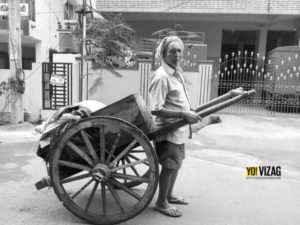 Once upon a time, salt was often purchased from hand-drawn carts specifically made for the purpose. With retail outlets now emerging as the sales point for the commodity, this 75-year-old continues what was once his father’s occupation. As he walks down the street, selling salt from door to door, his kind is reducing by the day, as the next generation opts for more lucrative jobs.
Once upon a time, salt was often purchased from hand-drawn carts specifically made for the purpose. With retail outlets now emerging as the sales point for the commodity, this 75-year-old continues what was once his father’s occupation. As he walks down the street, selling salt from door to door, his kind is reducing by the day, as the next generation opts for more lucrative jobs.
2.Scrap collector
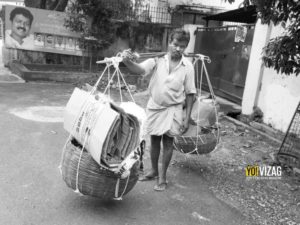 ‘Paatha Samaanlu Kontam’ was a phrase often heard on the streets in Vizag. However, the buyers of scrap are now a disappearing tribe. As we catch a glimpse of this seller in CBM compound, we see him balancing his kavidi on his shoulder, announcing himself on the streets as the buyer of scrap. His work involves carrying scrap of up to ten kilos before he can go to the shop and exchange it for money. While this is hard work, he does it with pride, adding that this is what pays for the school fees of his children.
‘Paatha Samaanlu Kontam’ was a phrase often heard on the streets in Vizag. However, the buyers of scrap are now a disappearing tribe. As we catch a glimpse of this seller in CBM compound, we see him balancing his kavidi on his shoulder, announcing himself on the streets as the buyer of scrap. His work involves carrying scrap of up to ten kilos before he can go to the shop and exchange it for money. While this is hard work, he does it with pride, adding that this is what pays for the school fees of his children.
3.GangiReddhu
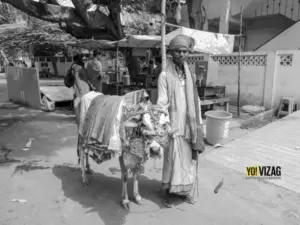 A brightly adorned bull accompanied by men in bright clothes marks the arrival of the Gangireddhu. Known to bring good luck, the 60s saw the Gangireddhu touring the neighbourhood, as each home sought blessings and gave a vessel of rice in return. The bull would even answer questions by nodding its head or perform a few feats. With independent homes being replaced by apartments, this has become a rare sight to see.
A brightly adorned bull accompanied by men in bright clothes marks the arrival of the Gangireddhu. Known to bring good luck, the 60s saw the Gangireddhu touring the neighbourhood, as each home sought blessings and gave a vessel of rice in return. The bull would even answer questions by nodding its head or perform a few feats. With independent homes being replaced by apartments, this has become a rare sight to see.
4.The door-to-door vegetable seller
 A few decades ago in Vizag, mornings did not mean rushing to the market for vegetables, as the sellers would themselves come home, with the assortment of vegetables of one’s choice. Often being the cultivators themselves, they would get fresh produce from their farms. While we spot this woman balancing a woven basket of vegetables, going from door-to-door selling them, her kind is fast depleting, as many prefer to go shopping at the retail outlets instead.
A few decades ago in Vizag, mornings did not mean rushing to the market for vegetables, as the sellers would themselves come home, with the assortment of vegetables of one’s choice. Often being the cultivators themselves, they would get fresh produce from their farms. While we spot this woman balancing a woven basket of vegetables, going from door-to-door selling them, her kind is fast depleting, as many prefer to go shopping at the retail outlets instead.
5.The adda leaf seller
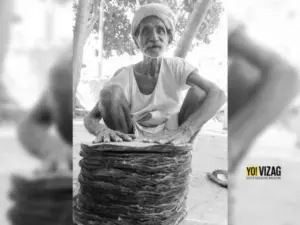 From the prasadam that was served in the temples to the eco-friendly option for karthik maasam picnics, vistarakulu, made from Adda-akulu are now replaced by thermocol and plastic. As this eco-friendly option is disappearing, its sellers too have become sparse. This 87-year-old is thus, one of a rare kind, seen once a month when he makes the six-hour trip from his tribal village to Vizag to sell these leaf-plates. The last vestiges of a fast disappearing eco-friendly practice, adda leaf plates may soon disappear with their aged makers and sellers.
From the prasadam that was served in the temples to the eco-friendly option for karthik maasam picnics, vistarakulu, made from Adda-akulu are now replaced by thermocol and plastic. As this eco-friendly option is disappearing, its sellers too have become sparse. This 87-year-old is thus, one of a rare kind, seen once a month when he makes the six-hour trip from his tribal village to Vizag to sell these leaf-plates. The last vestiges of a fast disappearing eco-friendly practice, adda leaf plates may soon disappear with their aged makers and sellers.
6.Parrot tarot reader
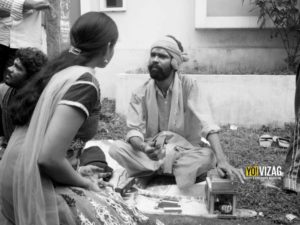 Dressed in bright colours with a caged parrot in one hand and a cloth bag with mysterious contents on one shoulder, the koya vadu, as he is called in local parlance, was a common sight in the old days. This fortune teller, belongs to the Koya Adivasi tribe, where both men and women traditionally took up this work. However, fortune telling is on the decline, as his kith and kin prefer other modes of work compared to this.
Dressed in bright colours with a caged parrot in one hand and a cloth bag with mysterious contents on one shoulder, the koya vadu, as he is called in local parlance, was a common sight in the old days. This fortune teller, belongs to the Koya Adivasi tribe, where both men and women traditionally took up this work. However, fortune telling is on the decline, as his kith and kin prefer other modes of work compared to this.
7.Potter
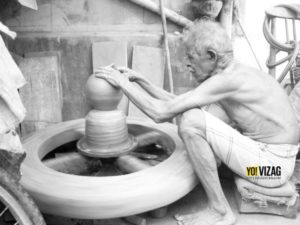 Once an integrated part of a family’s life, he would not only supply pots and pans regularly, but would also be called for special occasions like weddings. Payment would be made in kind, either through a bag of rice or other supplies. Soon, the barter system was replaced by monetary dealings. Today, that too is disappearing, as steel and plastic replace the eco-friendly pots. This 90-year-old’s life revolves around his potter’s wheel. From procuring the mud to finally creating the end products, he is one of the few people who continue this work and the knowledge of this craft may vanish with him.
Once an integrated part of a family’s life, he would not only supply pots and pans regularly, but would also be called for special occasions like weddings. Payment would be made in kind, either through a bag of rice or other supplies. Soon, the barter system was replaced by monetary dealings. Today, that too is disappearing, as steel and plastic replace the eco-friendly pots. This 90-year-old’s life revolves around his potter’s wheel. From procuring the mud to finally creating the end products, he is one of the few people who continue this work and the knowledge of this craft may vanish with him.
8.Rickshawwala
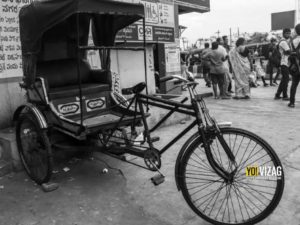 During the 60s, rickshaws were a luxury. With walking being a preferred way of going anywhere, spending the annas to hire a rickshaw, meant that one had money to afford. Today, these three-wheelers are on the brink of extinction. With eco-friendly rickshaw pullers few and far between, they are often plied by the old people. Replaced by the polluting autos, the takers for the rickshaw are few, and it may soon disappear.
During the 60s, rickshaws were a luxury. With walking being a preferred way of going anywhere, spending the annas to hire a rickshaw, meant that one had money to afford. Today, these three-wheelers are on the brink of extinction. With eco-friendly rickshaw pullers few and far between, they are often plied by the old people. Replaced by the polluting autos, the takers for the rickshaw are few, and it may soon disappear.
9.Knife sharpener
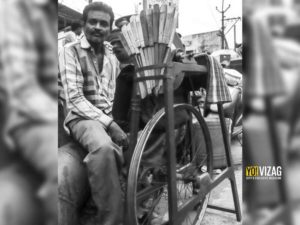 The sight of knives glinting in the sunlight on a cart with a cycle-wheel attached to it was once very popular. The foot-pedal operated wheel would sharpen the dull iron knives, and every home would have a potential customer for the knife sharpener. However, with stainless steel replacing iron, this occupation has lost its sheen in the market, and the fascinating sound of knives being sharpened is heard no more.
The sight of knives glinting in the sunlight on a cart with a cycle-wheel attached to it was once very popular. The foot-pedal operated wheel would sharpen the dull iron knives, and every home would have a potential customer for the knife sharpener. However, with stainless steel replacing iron, this occupation has lost its sheen in the market, and the fascinating sound of knives being sharpened is heard no more.
10.Haridasu
 Often from the farming community, the Haridasu or Bhagavatar would learn keertanas composed by Bhadrachalam Ramadasu at home. During the festive season, dressed in brightly coloured traditional attire, they walk the streets with an Akshaya patra balanced on their head. A Haridasu’s mesmerising voice singing Hari bhajans and Ramadasu keertanas, accompanied by his tanpura and chitikelu, would be a delightful sound in the morning’s silence. Never putting the patra down, never speaking, never asking for rice or money, their mellifluous songs are fast drowning in the blaring horns of vehicles.
Often from the farming community, the Haridasu or Bhagavatar would learn keertanas composed by Bhadrachalam Ramadasu at home. During the festive season, dressed in brightly coloured traditional attire, they walk the streets with an Akshaya patra balanced on their head. A Haridasu’s mesmerising voice singing Hari bhajans and Ramadasu keertanas, accompanied by his tanpura and chitikelu, would be a delightful sound in the morning’s silence. Never putting the patra down, never speaking, never asking for rice or money, their mellifluous songs are fast drowning in the blaring horns of vehicles.
11.Traditional oil seller
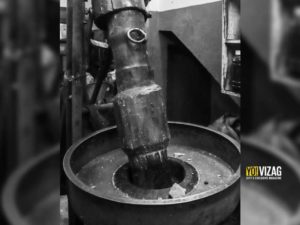 As refined oils promising a host of health benefits call out to us from retail outlets, and many of us are willing to shell out extra for the cold compressed oils, the traditional method of oil extraction becomes extinct. Our forefathers employed the traditional ganuga where a large heavy wooden grinder would be worked by a bull, and the extracted oil and dry cake would both be used for their benefits.
As refined oils promising a host of health benefits call out to us from retail outlets, and many of us are willing to shell out extra for the cold compressed oils, the traditional method of oil extraction becomes extinct. Our forefathers employed the traditional ganuga where a large heavy wooden grinder would be worked by a bull, and the extracted oil and dry cake would both be used for their benefits.
12.The hand-pounders
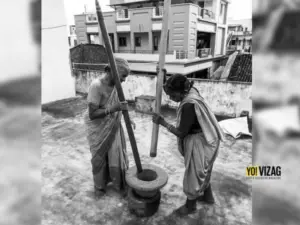 Be it the auspicious turmeric for weddings, the quintessential chillies during pickle season or even removing husk from rice and lentils, pounding by hand was an integral part of many homes. Worshipped during the festive season as Goddess Lakshmi, women were employed to operate this stone mortar and wooden pestle. The women would work with a perfect rhythm, in perfect unison to create fine powders of the chillies or turmeric. With mixers, grinders and readymade products replacing this hand-pounding equipment, the old timers often complain, that the quality and freshness from the pestle was much better.
Be it the auspicious turmeric for weddings, the quintessential chillies during pickle season or even removing husk from rice and lentils, pounding by hand was an integral part of many homes. Worshipped during the festive season as Goddess Lakshmi, women were employed to operate this stone mortar and wooden pestle. The women would work with a perfect rhythm, in perfect unison to create fine powders of the chillies or turmeric. With mixers, grinders and readymade products replacing this hand-pounding equipment, the old timers often complain, that the quality and freshness from the pestle was much better.


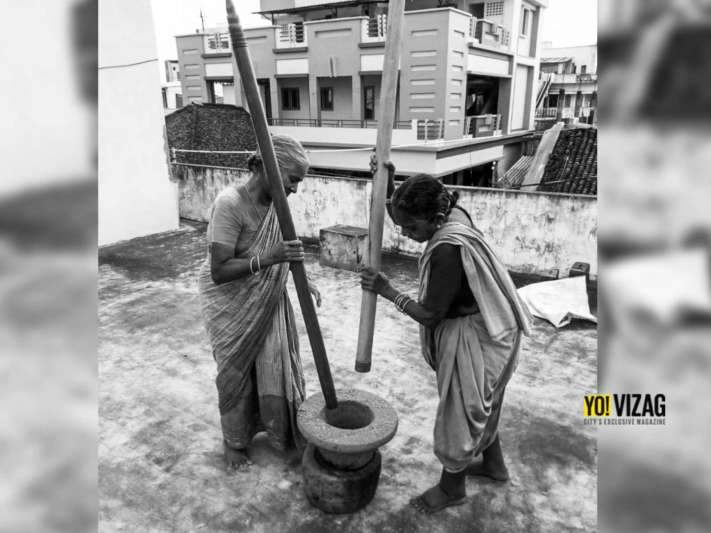





Discussion about this post